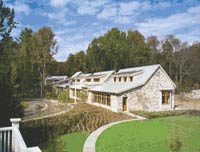view all Case Studies
Metal Roof Supports Rainwater Collection System, Helps School Earn LEED Certification

The first school in New Jersey to earn the U.S. Green Building Council's Leadership in Energy and Environmental Design (LEED) Gold certification is no ordinary K-8 facility.
May 28, 2007 -
Facilities Management
The first school in New Jersey to earn the U.S. Green Building Council's Leadership in Energy and Environmental Design (LEED) Gold certification is no ordinary K-8 facility.
Founder Mark Biedron wanted his children to go to a school that uses a hands-on approach to learning through nature. Because he could not find the exact characteristics he was looking for in an existing school in his hometown of Gladstone, N.J., Biedron and his wife, Gretchen, decided to design their own making it the nation's first independent school to achieve LEED certification.
Biedron wanted to design a school that was in sync with the curriculum, which teaches that students must understand their place in the world and in nature. That made sustainability and ecology important factors in the design of the building.
The school was designed to merge aesthetically with the site, and the materials employed were either salvaged or had a high percentage of recycled content.
One key feature of the school is the Follansbee's TCS II roof, an architectural stainless steel coated with Follansbee's ZT (zinc/tin) alloy. The roof helped support Biedron's goal of creating a green school not only because it contains between 70 percent and 90 percent recycled content, but also because it serves as a water collection system.
Runoff from the low-maintenance, solderable roof is collected and stored in a 57,000-gallon underground tank. The water is then utilized to flush toilets and for irrigation. The coating on the standing seam metal roof does not require painting, weathers naturally to an attractive gray patina, and can withstand severe corrosive conditions including industrial, coastal, and salt-water environments.
Other green design features at the school include operable windows, natural lighting, an HVAC system that only operates when necessary, salvaged bluestone walkways, flooring made of cork and linoleum, desks constructed of wood from trees harvested at the site and bathroom stall doors made from recycled detergent bottles.








